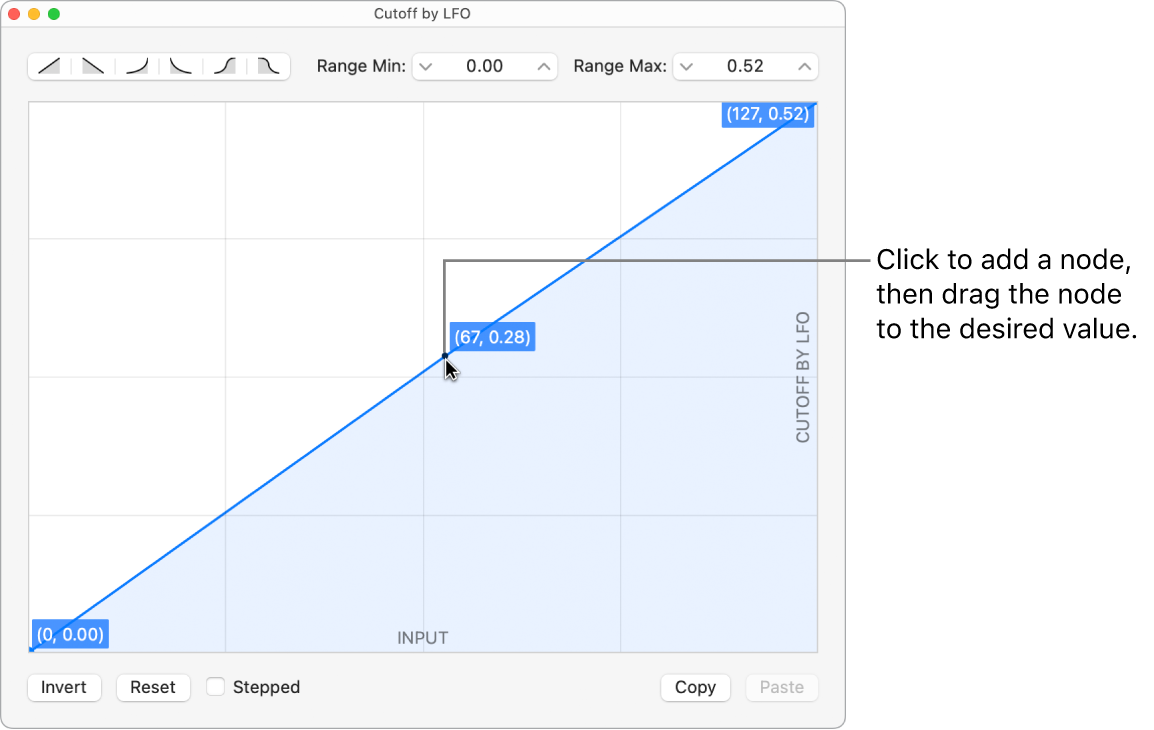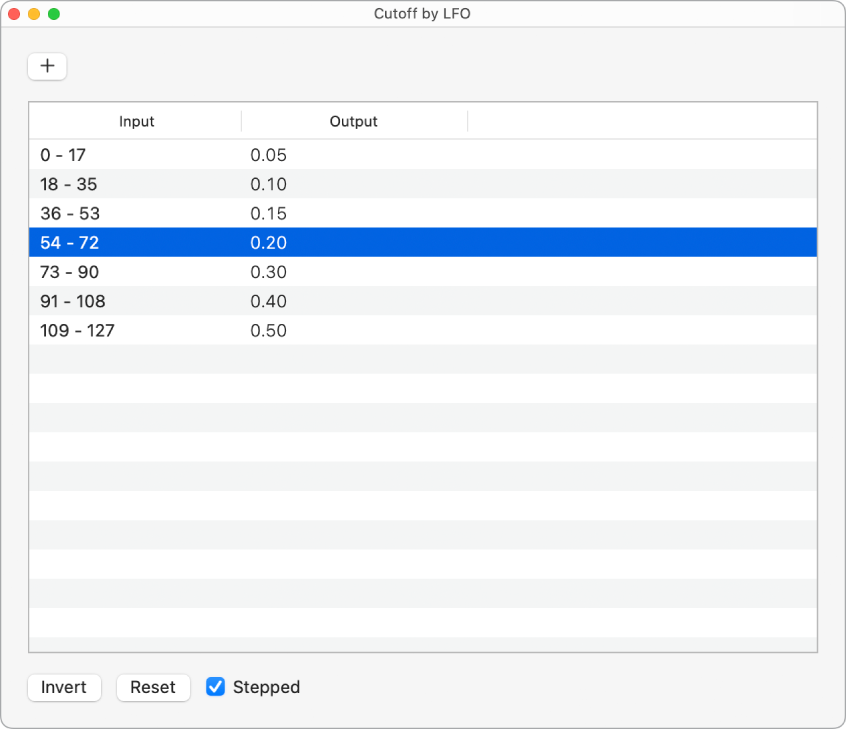MainStage User Guide
- Welcome
-
- Overview of Edit mode
-
- Select patches and sets in the Patch List
- Copy, paste, and delete patches
- Reorder and move patches in the Patch List
- Add and rename patches
- Create a patch from several patches
-
- Overview of the Patch Settings Inspector
- Select patch settings in the Patch Library
- Set the time signature for patches
- Change the tempo when you select a patch
- Set program change and bank numbers
- Defer patch changes
- Instantly silence the previous patch
- Change patch icons
- Transpose the pitch of incoming notes for a patch
- Change the tuning for a patch
- Add text notes to a patch
-
- Overview of channel strips
- Add a channel strip
- Change a channel strip setting
- Configure channel strip components
- Show signal flow channel strips
- Hide the metronome channel strip
- Create an alias of a channel strip
- Add a patch bus
- Set channel strip pan or balance positions
- Set channel strip volume levels
- Mute and solo channel strips
- Use multiple instrument outputs
- Use external MIDI instruments
- Reorganize channel strips
- Delete channel strips
-
- Overview of the Channel Strip Inspector
- Choose channel strip settings
- Rename channel strips
- Change channel strip colors
- Change channel strip icons
- Use feedback protection with channel strips
- Set keyboard input for a software instrument channel strip
- Transpose individual software instruments
- Filter MIDI messages
- Scale channel strip velocity
- Set channel strips to ignore Hermode tuning
- Override concert- and set-level key ranges
- Add text notes to a channel strip in the Channel Strip Inspector
- Route audio via send effects
-
- Screen Control Inspector overview
- Replace parameter labels
- Choose custom colors for screen controls
- Change background or grouped screen control appearance
- Set screen controls to show the hardware value
- Set parameter change behavior for screen controls
- Set hardware matching behavior for screen controls
- Reset and compare changes to a patch
- Override concert- and set-level mappings
-
- Overview of mapping screen controls
- Map to channel strip and plug-in parameters
- Map screen controls to actions
- Map a screen control to multiple parameters
- Use screen controls to display PDF document pages
- Edit the saved value for a mapped parameter
- Set drum pads or buttons to use note velocity
- Map screen controls to all channel strips in a patch
- Undo screen control parameter mappings
- Remove screen control mappings
- Work with graphs
- Create controller transforms
- Share patches and sets between concerts
- Record the audio output of a concert
-
- Overview of concerts
- Create a concert
- Open and close concerts
- Save concerts
- How saving affects parameter values
- Clean up concerts
- Consolidate assets in a concert
- Rename the current concert
-
- Overview of the Concert Settings Inspector
- Set MIDI Routing to channel strips
- Transpose incoming note pitch for a concert
- Define the program change message source
- Send unused program changes to channel strips
- Set the time signature for a concert
- Change the tuning for a concert
- Set the pan law for a concert
- Add text notes to a concert
- Control the metronome
- Silence MIDI notes
- Mute audio output
-
- Layout mode overview
-
- Screen control parameter editing overview
- Lift and stamp screen control parameters
- Reset screen control parameters
- Common screen control parameters
- Keyboard screen control parameters
- MIDI activity screen control parameters
- Drum pad screen control parameters
- Waveform screen control parameters
- Selector screen control parameters
- Text screen control parameters
- Background screen control parameters
- How MainStage passes through MIDI messages
- Export and import layouts
- Change the aspect ratio of a layout
-
- Before performing live
- Use Perform mode
- Screen controls in performance
- Tempo changes during performance
- Tips for performing with keyboard controllers
- Tips for performing with guitars and other instruments
- Tune guitars and other instruments with the Tuner
- The Playback plug-in in performance
- Record your performances
- After the performance
- Tips for complex hardware setups
-
- Overview of keyboard shortcuts and command sets
-
- Concerts and layouts keyboard shortcuts
- Patches and sets (Edit mode) keyboard shortcuts
- Editing keyboard shortcuts
- Actions keyboard shortcuts
- Parameter mapping (Edit mode) keyboard shortcuts
- Channel strips (Edit mode) keyboard shortcuts
- Screen controls (Layout mode) keyboard shortcuts
- Perform in Full Screen keyboard shortcuts
- Window and view keyboard shortcuts
- Help and support keyboard shortcuts
-
-
- Use MIDI plug-ins
-
- Arpeggiator overview
- Arpeggiator control parameters
- Note order parameters overview
- Note order variations
- Note order inversions
- Arpeggiator pattern parameters overview
- Use Live mode
- Use Grid mode
- Arpeggiator options parameters
- Arpeggiator keyboard parameters
- Use keyboard parameters
- Assign controllers
- Modifier controls
- Note Repeater controls
- Randomizer controls
-
- Use Scripter
- Use the Script Editor
- Scripter API overview
- MIDI processing functions overview
- HandleMIDI function
- ProcessMIDI function
- GetParameter function
- SetParameter function
- ParameterChanged function
- Reset function
- JavaScript objects overview
- Use the JavaScript Event object
- Use the JavaScript TimingInfo object
- Use the Trace object
- Use the MIDI event beatPos property
- Use the JavaScript MIDI object
- Create Scripter controls
- Transposer controls
-
-
- Alchemy overview
- Alchemy interface overview
- Alchemy Name bar
- Alchemy file locations
-
- Alchemy source overview
- Source master controls
- Import browser
- Source subpage controls
- Source filter controls
- Source filter use tips
- Source elements overview
- Additive element controls
- Additive element effects
- Spectral element controls
- Spectral element effects
- Pitch correction controls
- Formant filter controls
- Granular element controls
- Sampler element controls
- VA element controls
- Wide unison mode
- Source modulations
- Morph controls
- Alchemy master voice section
- Alchemy Extended parameters
-
- Playback plug-in overview
- Add a Playback plug-in
- Playback interface
- Use the Playback waveform display
- Playback transport and function buttons
- Playback information display
- Playback Sync, Snap To, and Play From parameters
- Use the Playback group functions
- Use the Playback Action menu and File field
- Use markers with the Playback plug-in
-
- Sample Alchemy overview
- Interface overview
- Add source material
- Edit mode
- Play modes
- Source overview
- Synthesis modes
- Granular controls
- Additive effects
- Additive effect controls
- Spectral effect
- Spectral effect controls
- Filter module
- Lowpass, bandpass, and highpass filters
- Comb PM filter
- Downsampler filter
- FM filter
- Envelope generators
- Mod Matrix
- Modulation routing
- Motion mode
- Trim mode
- More menu
-
- Sculpture overview
- Sculpture interface
- Global parameters
- Amplitude envelope parameters
- Use the Waveshaper
- Filter parameters
- Output parameters
- Define MIDI controllers
- Extended parameters
-
- Studio Piano
- Copyright

Work with graphs in MainStage
Each parameter mapping has a Parameter graph. You can edit the graph to remap input values to different output values for the parameter. Using graphs, you can graphically remap the values for some MIDI control messages so that input values from your controller produce different output values for the channel strip or plug-in parameter. Graphs make it easier to see and modify a range of values for a parameter, such as velocity or filter cutoff.
You can use graphs for the following types of parameters:
Controller transforms
Velocity scaling (both input velocity and note input)
Parameters to which a screen control is mapped
You open a graph window by clicking the button for that type of graph in the appropriate Inspector. The Transform and Velocity Scaling graphs for the selected channel strip are available in the MIDI Input tab of the Channel Strip Inspector. The Parameter graph for the selected screen control is available in the tab for the individual mapping, as well as in the Mappings tab in the (Edit mode) Screen Control Inspector.
The graph shows the range of input values on the horizontal (x) axis, moving from left to right, and shows the range of output values on the vertical (y) axis, moving from bottom to top.
In the graph window, you have several ways of working. You can edit the graph curve directly, edit values numerically using the Precision Editor, or use the Curve buttons to set the graph to one of the predefined curves.
Edit a graph
In MainStage, select the channel strip or screen control you want the graph to apply to.
Select the MIDI Input tab (for transform and velocity scaling graphs) or the Mapping tab (for parameter mapping graphs).
Click the graph button for the type of graph you want to edit.
In the graph window, do one of the following:
To set the graph to one of the preset curves, click one of the Curve buttons.
Click the curve at the point where you want to add a node, then drag the node to the desired value. Drag horizontally to change the input value, or vertically to change the output value.
As you drag, the current values of the node appear next to the pointer.

Double-click the curve at the point where you want to add a node, then edit the values for the node in the Precision Editor.
To delete a node, click to select it, then press Delete.
Option-click any part of the curve (except a node), then drag the dotted part of the curve to make the curve nonlinear.
Continue adding and adjusting points on the curve until you achieve the result you want.
When you finish, click the close button at the upper-left corner of the graph window, or press the Escape (Esc) key.
After you have edited a graph, the button for the graph in the Inspector shows the edited shape of the graph in a dark blue color to make it easier to identify which graphs you have edited and how.
Create a stepped graph
In the MainStage graph window, select the Stepped checkbox.
The graph window shows two steps, with input and output values.
To add steps, click the Add (+) button.
To change the input or output values for a step, click the value, then drag vertically.

Copy and paste values
In the MainStage graph window, click the Copy button.
Open the graph you want to paste the values into, and click the Paste button.
Invert the values of the graph
In MainStage, do one of the following:
In the graph window, click the Invert button.
In the tab for the mapping, select the Invert Parameter Range checkbox.
Reset the graph to its default values
In MainStage, click the Revert to Default button at the top of the graph window.
Close the graph window
In MainStage, click the close button at the upper-left corner of the graph window, or press the Escape (Esc) key.
Most of the ways you edit graphs are the same regardless of the type of graph, although there are a few features specific to one or another type. For Parameter graphs, you can change the minimum and maximum range values for the graph using the Range Min and Range Max value sliders. For more information, see Create controller transforms in MainStage and Scale channel strip velocity in MainStage.